3D Printing Steals the Show at Euromold 2015
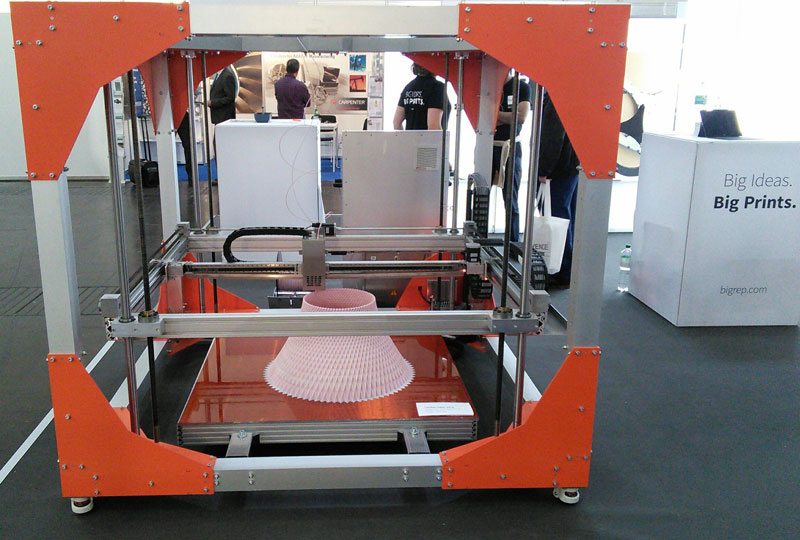
BigRep ONE has a build volume 1 sq. meter in size. (Photo by Randall Newton)
Latest News
October 2, 2015
Euromold 2015 was an all-new conference and trade show in many ways, even though it is more than 20 years old. Euromold moved from Frankfurt to Düsseldorf and from November to September — but the biggest change was the increased emphasis on 3D printing.
Where once 3D printing was an interesting sideshow for a larger conference on molding and toolmaking, it is now the main event, with more than a third of all Euromold 2015 vendors active in additive manufacturing or other aspects of 3D printing. (The terms “additive manufacturing” and “3D printing” were used interchangeably during the conference.) The changes in date and location may have cost them a few trade show vendors (EOS and Stratasys were only represented by resellers), but the conference side of the event grew from one day hosted by Wohlers Associates to three days shared by Wohlers and the Society for Manufacturing Engineers (SME).
Despite the usual gush of pie-in-the-sky from some vendors, there was a big emphasis on getting down to business. Much of the talk in the sessions and on the show floor was about new materials and expanding existing markets. The sales inquiries are starting to move from complexity to productivity. “Our sales have become like selling CNC machines,” said Martin Forth of EnvisionTec. “They ask ‘how fast, how much per part ... ’”
EnvisionTec manufactures Digital Light Processing (DLP) 3D printers, and has found a growing market in custom work including designer jewelry, figurines and dental work. A new area opened for them this year in custom eyewear. Boulton Eyewear specializes in custom, fitted eyewear frames. Boulton worked out how to generate a 3D dataset of a client’s face from photos, making it possible to print a pair of glasses (no lenses) as tailor-made as a Hong Kong suit. The company is now using an EnvisionTec printer and R5 Acrylic to print five pair at a time, several times a day. “You really do notice a difference” when a pair of glasses is created custom to your face, says Forth.
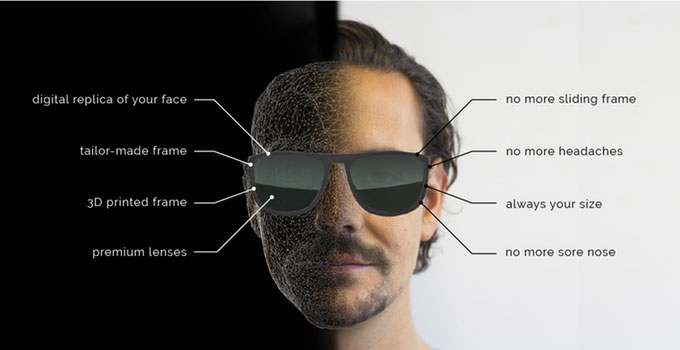 Boulton Eyewear creates 3D data from photos of the face then prints a pair of eyeglasses custom to the client using an EnvisionTec DLP 3D printer. (Source: Boulton Eyewear).
Boulton Eyewear creates 3D data from photos of the face then prints a pair of eyeglasses custom to the client using an EnvisionTec DLP 3D printer. (Source: Boulton Eyewear).New materials are coming online at a faster rate than ever before, but it isn’t fast enough for some 3D printing enthusiasts. “We have 30 common additive manufacturing alloys,” says Edward Herderick of General Electric. “But we need hundreds!” One answer to the lack of suitable metals for 3D printing will come with new hardware, like the new extra-large electron beam additive manufacturing (EBAM) system from the Sciaky division of Phillips Service Industries. The Sciaky EBAM 11p is a room-sized printer capable of printing parts ranging from 203 mm (8 in.) to 5.79 meters (19 ft.) in length. Optional dual wire-feed allows for combining of two metal alloys into a single melt pool to create a custom material; the mixture ratio can also be adjusted for creating graded parts. Available metals include titanium, tantalum, niobium, tungsten, molybdenum, Inconel, aluminum, stainless steels, nickel alloys and more.
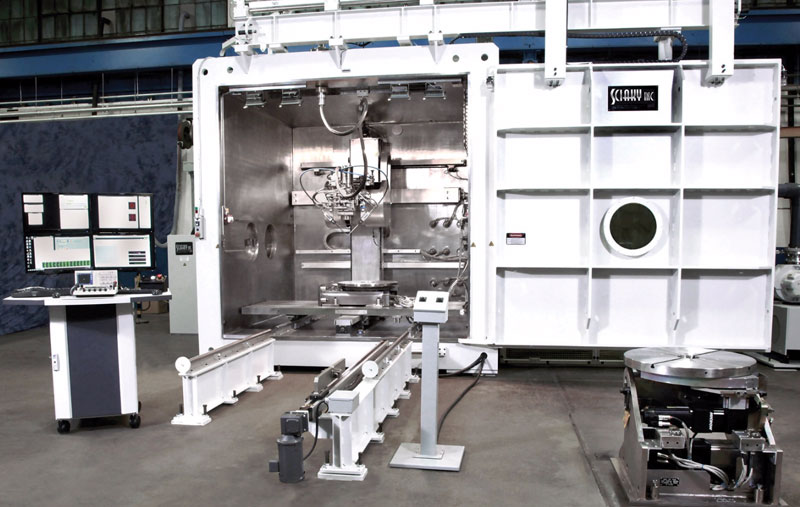 The new Sciaky EBAM 110 from Phillips can print parts up to 19 feet in length. (Image source: Phillips)
The new Sciaky EBAM 110 from Phillips can print parts up to 19 feet in length. (Image source: Phillips)Taking Advantage of Patent End of Life
At least 34 of the more than 300 vendors of budget-class stereolithography (SLA) and Fused Deposition Modeling-like (FDM) printers came to Euromold, most of them new vendors taking advantage of end-of-life on many key SLA or FDM patents. About the only thing separating these “me-too” printers were build size and country of origin. But there were standouts among the newcomers.
The Profi3DMaker from 3Dfactories of Germany offers a stable aluminum frame for a printing area of 400x260x190 mm (15.7x10.23x7.48 in.). An optional smaller nozzle takes resolution as low as 0.3 mm. It uses both PLA and ABS plastics, and retails for €3,649 (about $4,100 USD).
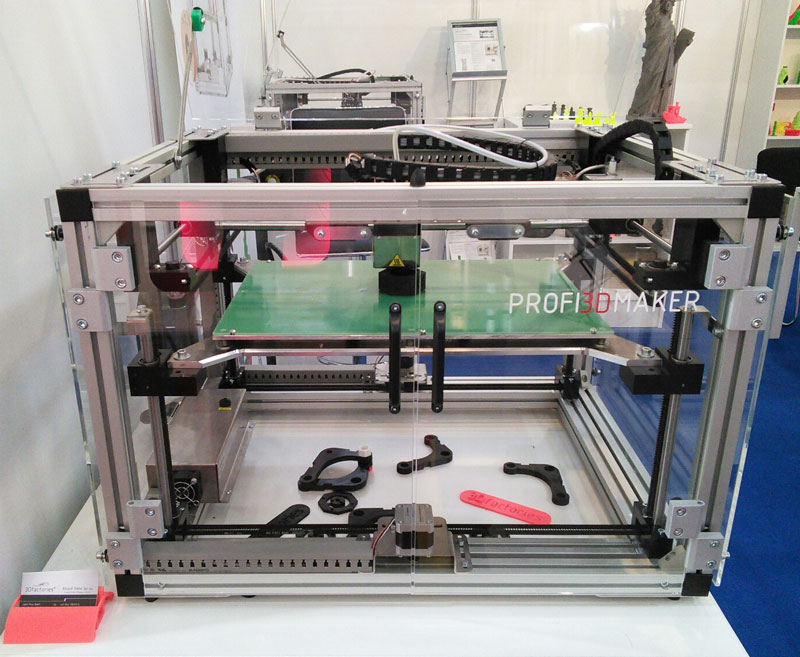 The Profi3DMaker from 3Dfactories offers a large build area and uses both PLA and ABS filament for printing. (Photo by Randall Newton)
The Profi3DMaker from 3Dfactories offers a large build area and uses both PLA and ABS filament for printing. (Photo by Randall Newton)The BigRep ONE is the latest printer to market based on the reprap open source standard. It features a 1m2 build volume, making it the world’s largest commercially available FDM 3D printer. It features dual extruders and can print PLA, ABS, PVA, HDPE, PC, Nylon, TPE, Laywood, and Laybrick materials. The print quality is 100 microns. The price is €39,000 (almost $44,000 USD).
 BigRep ONE has a build volume 1 sq. meter in size. (Photo by Randall Newton)
BigRep ONE has a build volume 1 sq. meter in size. (Photo by Randall Newton)Key original patents have also expired on Selective Laser Sintering (SLS), a 3D printing method that uses a laser to sinter powdered metal (or other materials). New crowdfunded vendor Sintratec used Euromold to launch a low-cost SLS 3D printer in kit form with a show-special price of €4,499 (almost $5,100 USD). The company also announced the Sintratec 1, a fully assembled SLS printer with a build volume of 150x150x200 mm (5.9x5.9x7.8 in.).
With SLS being able to build in metal, ceramic, plastic or glass, and with the expiration of key original patents, the next year or two should see a variety of new SLS printers come to market. This will expand the low end and create market differentiation among vendors between low cost and high quality.
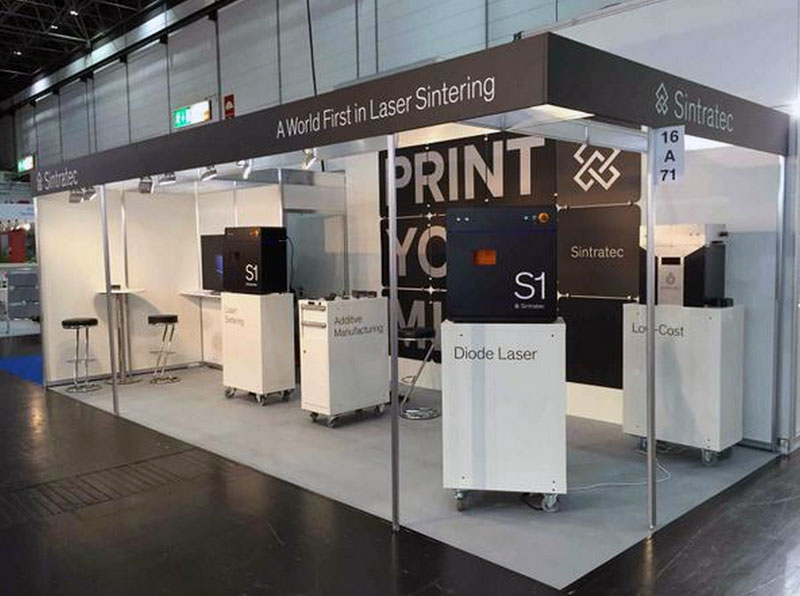 The Sintratec 1 is an early entry in the race to build new lower-cost selective laser sintering 3D printers. (Image source: Sintratec)
The Sintratec 1 is an early entry in the race to build new lower-cost selective laser sintering 3D printers. (Image source: Sintratec)Printing Functional Electronics
Voxel8 was a new printer vendor attracting attention for the opposite reason of those building from expired patents. Based on the work of Dr. Jennifer Lewis at Harvard University, Voxel8 offers both the printer and materials to create novel 3D electronic devices. (For more, read 3D Printed Electronics Get Real.) The Voxel8 printer co-prints in two materials, including a proprietary conductive ink that allows the creation of 3D printed electronics. The conductive ink contains silver and requires no annealing or other post-printing prep work beyond 5 minutes of final curing. The build volume is 10x15x10 cm (4x6x4 in.), with a layer resolution of 400 microns.
Daniel Oliver, Voxel8 co-founder and business development lead, said the company is intentionally thinking about “moving from form to function” in 3D printing. The technology they pursue is called direct ink writing, the deposition of viscous paste through a nozzle. “This is a paste, not water-like liquids,” Oliver stressed. “Multi-material printing is the key to functional electronic devices.”
The custom software to run the Voxel8 (Autodesk Project Wire) is cloud-based and supports both Chrome and Firefox. Under development are ink designs that will allow 3D printing of resistors, dielectrics, stretchable electronics and sensors, and lithium ion batteries. The Somerville, MA company is taking advanced orders at $8,999 for delivery before the end of 2015.
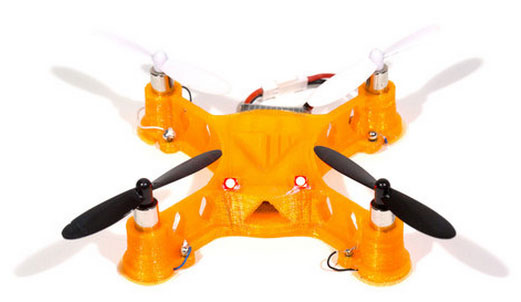 The Voxel8 printer can print electronic devices such as this quadcopter. (Image source: Voxel8)
The Voxel8 printer can print electronic devices such as this quadcopter. (Image source: Voxel8)Design for Printing, not Manufacturing
During a conference session on industry trends, a question came up about designing for 3D printing. “We have a lot of work to do in getting people to think in a different way,” said Phill Dickens, a professor of manufacturing technology at the University of Nottingham (UK). It requires going back to the original physics or the nature of the problem: “Go back to the beginning: think ‘current goes in, rotation goes out,’ not ‘what are the size of the gears.’”
We need a generation that can “think additively” said Ingomar Kelbassa, a vice president at Fraunhofer ILT (Institute for Laser Technology). “Don’t think about manufacturing at first, think about the additive process. We have to think differently about these systems. We are too far from first time right today.”
Stephen Nigro, president of a new HP division focused on 3D printing, agreed with the need for education, but noted it can’t wait for a new generation to graduate and mature. “There is an element of needing to make the case to businesses on the value of additive manufacturing today. Businesses are like lemmings, once you get enough business leaders aboard, then everyone jumps on.”
Perhaps what we need is a digital design guide, added Rob Gorman, director of operations at America Makes, the National Additive Manufacturing Innovation Institute launched by the White House in 2014. “There is no lack of imagination, but there is a lack of guidance to embrace what is being imagined. We need a digital design guide, something that can be an enabler of imaginative spirit.”
A Long Road Ahead
Despite the general optimism among both vendors and attendees, there was also a general sense that, despite the wide variety of machines and materials and the billions being spent, 3D printing for manufacturing is an industry in its infancy. HP’s Nigro shared economic projections originally published by Terry Wohlers, noting that if 3D printing only attracts 5% of total manufacturing revenue in 2020, that will make 3D printing a $21 billion business.
“3D printing is a massive opportunity,” said Nigro. “We can change the industry and affect economies by decreasing manufacturing footprint on the globe.” But it will require “a level of collaboration allowing all to benefit ... The industry has to create standards; everybody will benefit. There is a huge market opportunity if we come together.”
Related Information
Subscribe to our FREE magazine, FREE email newsletters or both!
Latest News
About the Author
Jamie Gooch is the former editorial director of Digital Engineering.
Follow DE





